Molecular mechanism analysis of Miao medicine Jinwujiangu decoction (金烏健骨方) in treating osteoarthritis based on a network pharmacology approach
JIANG Zong,YAO Xiaoling,MA Wukai,TANG Fang
JIANG Zong,MA Wukai,TANG Fang,Department of Rheumatology,the Second Affiliated Hospital of Guizhou University of Traditional Chinese Medicine,Guiyang 550002,China
YAO Xiaoling,Department of Traditional Chinese Medicine,Longhua District Central Hospital,Shenzhen 518110,China
Abstract OBJECTIVE:To investigate molecular mechanisms of Jinwujiangu decoction (金烏健骨方,JWJG) in treating osteoarthritis (OA) using network pharmacology analysis.METHODS:Principal active compounds of JWJG were screened out via the Traditional Chinese Medicine Systems Pharmacology Database and Analysis Platform(TCMSP) and BATMAN-TCM,and potential targets for OA treatment were identified through Online Mendelian Inheritance in Man (OMIM) and GeneCards databases.The JWJG network diagrams of both principal chemical compound-action targets and OA treatment target-OA disease were constructed applying the Cytoscape 3.7.2 software.The diagram of protein-protein interaction network was plotted for core analysis.Meanwhile,the common targets and relevant signaling pathways involved in both networks were analyzed using the Gene Ontology function analysis and Kyoto Encyclopedia of Genes and Genomes pathway enrichment.The predicted results were ultimately verified through animal experiments.RESULTS:Effects of JWJG were indicated in acting on key targets interleukin-6,insulin,protein kinase B,glyceraldehyde-3-phosphate dehydrogenase,and mitosis-specific MRE11-RAD50-NBS1 associated protein by regulating signaling pathways of phosphoinositide 3-kinase-protein kinase B,mitogen-activated protein kinases,tumor necrosis factor,and colorectal cancer.Meanwhile,it inhibited the over-activation of signaling pathways and the release of inflammatory factors in OA treatment.Following a signaling pathway analysis utilizing network pharmacology technique,it was demonstrated that JWJG could treat OA through the Wnt/β-catenin signaling pathway verified by animal experiments.CONCLUSIONS:The present study preliminarily analyzed the pharmacological mechanism of JWJG in treating OA on a network pharmacology approach and provided a great theoretical significance for clinical application.
Keywords:osteoarthritis;network pharmacology;targets;Jinwujiangu decoction
1.INTRODUCTION
OA represents an aseptic,low inflammatory disorder that frequently occurs in the musculoskeletal system,1and its incidence is positively correlated with the increase of age.2Impairment of joint structural homeostasis causes inflammatory changes in muscles,bones,and relevant appendages.This disease may affect all joints of the body,with knee joint involvement the most common.3The major clinical manifestations include progressive limitation of joint movement and aggravation of longterm chronic pain.4The therapeutic options available are early symptomatic pain relief,delayed joint destruction,and later surgical treatment.5Novel therapies ozonotherapy and mesenchymal stem cell transplantation have also achieved an acceptable efficacy in a short term.6,7However,the lack of clinical evidence,uncertain longterm effects,and unclear adverse effects bring about constant challenges in clinical practice.In summary,a recognized therapy with satisfactory effects and fewer side effects remains necessary.
The Miao medicine Jinwujiangu decoction (金烏健骨方,JWJG) is an effective empirical prescription of OA treatment in rheumatism immunology,composed of Jinmaogouji (Cibotium Barometz) 15 g,Wushaoshe(Zaocys) 10 g,Heiguteng (Periploca Forrestii Schltr.)10 g,Qiannianjian (Rhizoma Homalomenae)15 g,Baishao (Radix Paeoniae Alba) 15 g,Sanqi (Radix Notoginseng) 5 g,Jianghuang (Rhizoma Curcumae Longae) 10 g and Qingfengteng (Caulis Sinomenii) 10 g.Previous clinical studies have revealed that JWJG can reduce visual analogue scores and ISOA scores,and downregulate serum interleukin (IL)-6 and tumor necrosis factor (TNF)-α in OA patients.8TCM formula is characterized by multi-drugs,multi-compounds,and multi-targets.The occurrence and development of OA also involve complex processes of diverse molecular changes.The role of the TCM formula in OA treatment should be investigated in integrity rather than separately.The Wnt signaling pathway plays a major role in the course of OA identified through gene sequence.When the Wnt signaling pathway is continuously activated,Wnt protein can bind to Frz and the ligand low-density lipoprotein-related receptors 5 and 6.Wnt signals are subsequently transferred extranuclear to the cytoplasm for further release of Dsh,thereby disintegrating the complex formed by Axin,GSK-3β,and β-catenin.As the disintegrated and non-phosphorylated β-catenin accumulates,the concentration gradient in the cytoplasm changes.Binding with Tcf segments in the nucleus causes the expression of Wnt related target genes and activates the transcription and expression of downstream target genes of Wnt signals,9,10thereby participating in chondrocyte maturation and apoptosis.11The balance of osteoblasts and osteoclasts can mediate the cartilage metabolism and subsequently participate in OA progression.Utilizing the network pharmacology approach,the active compounds and main action targets of JWJG in the treatment of OA were predicted,and whether JWJG inhibited proliferation,differentiation,and apoptosis of chondrocytes in the presence of the Wnt signaling transduction pathway was explored.
2.METHODS
2.1.Retrieval of the main chemical compounds of JWJG
A total of 66 main chemical compounds of Jinmaogouji(Cibotium Barometz),Wushaoshe (Zaocys),and Heiguteng (Periploca Forrestii Schltr.) were extracted from literature.Meanwhile,33 main chemical compounds of the additional five Chinese herbs Qiannianjian (Rhizoma Homalomenae),Baishao (Radix Paeoniae Alba),Sanqi (Radix Notoginseng),Jianghuang(Rhizoma Curcumae Longae),and Qingfengteng (Caulis Sinomenii) were sorted out through the TCMSP database(http://www.tcmspw.com/tcmsp.php).
2.2.Screening of active compounds
The compounds of the five described herbs were sorted using the TCMSP database under the conditions of oral bioavailability (OB) ≥ 30% and drug likeness (DL) ≥0.18.The compounds of the rest three drugs were collected from the ChemMapper database (http://lilabecust.cn/chemmapper/).
2.3.Drug target conversion and screening of disease targets
The target IDs of the drugs were obtained from the UniProt database (https://www.uniprot.org/) and converted into the corresponding names of the GeneCards database (https://www.genecards.org/).The keyword "osteoarthritis" was input to screen the disease targets,and OA-related genes were exported from the GeneCards and Online Mendelian Inheritance in Man(OMIM) databases.Overlapped targets of OA genes and JWJG target genes were obtained which were the action targets of JWJG in OA treatment.
2.4.Network diagram construction of active compoundaction target-disease
The network diagram of JWJG compound targets-CRC targets using the candidate chemical compounds and OA targets was constructed using Cytoscape version 3.7.2(U.S.National Institute of General Medical Sciences,MD,USA).The compound degrees represented the corresponding target number of OA treatments and much priority was given to the compounds with higher degrees.
2.5.Protein-protein interaction (PPI) network construction
To systematically illustrate interactions between target proteins,therapeutic target genes of JWJG in OA treatment were imported into the online String database(https://string-db.org/).Data with the highest confidence coefficient (>0.9) were used for PPI network construction and the bar charts were plotted using the R 3.6.1 software (https://www.r-project.org/).
2.6.Gene Ontology (GO) and Kyoto Encyclopedia of Genes and Genomes (KEGG) analysis
To elucidate the roles of target proteins of TCM compounds play in gene functions and signaling pathways,this study carried out enrichment analysis of GO function and KEGG pathways of the PPI network proteins using DAVID database (https://david.ncifcrf.gov/).
2.7.Animal experimental materials and methods
This study followed the management methods for laboratory animals of Guizhou University of Traditional Chinese Medicine and abode by the requirements of the Ethics Committee of Guizhou University of Traditional Chinese Medicine.A total of 70 healthy New Zealand white rabbits (half males and half females) aged 4-5 months,weighing 1.5-2.5 kg,were bred in separate cages.The animals were provided by the Laboratory Animal Center of Guizhou Medical University,certificate No.SCXK (Qian) 2012-0001.Their diets were from the Guizhou Academy of Agricultural Sciences.All rabbits were randomly divided into 7 groups,10 in each group(5 males and 5 females) including a normal saline group,a model saline group,a meloxicam control group,a glucosamine control group,a low dose JWJG group,a medium dose JWJG group,and a high dose JWJG group.Following the preparation of 4% papain saline solution,a 0.2 mL mixture was injected into the left knee joint on days 1,4,and 7 during the experiment.A stable animal model of degenerative arthritis was established.At week 5,intragastric administration of different drugs was given to the meloxicam control group,glucosamine control group,low dose JWJG group,and the medium dose JWJG group,respectively,and an equal volume of normal saline was given to the blank and the model groups.
2.8.Drug treatment and pathological examination
JWJG (the 2nd Affiliated Hospital of Guizhou University of TCM,Permit No.Qian Yao Zhi Zi Z20160028,Batch number:20181001),Glucosamine Hydrochloride Capsules (Bright Future,Hongkong,China),Meloxicam,(Yangtze River Pharmaceutical Group,Jiangsu,China).The adult dosage of JWJG was 90 g,which was converted to the equivalent dose of rabbit at 9 g/kg.This equivalent dose was introduced as the medium dose (9 g/kg),half of the equivalent dose was administered as a low dose (4.5 g/kg),and 3 times as a high dose (27 g/kg).The equivalent dose of meloxicam in the positive control group was 3.5 mg/kg and the equivalent dose of glucosamine was 75 mg/kg.12The rabbits were sacrificed by overinjection of sodium pentobarbital (100 mg/kg).Upon completion of the experiment,superior cartilage of the left femoral condylar apex calcified layer was taken and prepared as specimens in each group.The specimens were fixed with neutral formaldehyde,decalcified with nitric acid,embedded in conventional paraffin,and sectioned subsequently for hematoxylin-eosin (HE)staining.The specimen pathology of each group was observed by specific personnel,and the pathological changes in cartilage were scored according to Mankin's.13The protein expressions of β-catenin,Axin,and GSK-3β were detected by western blot,and those of wnt2a,wnt5a,bone morphogenetic protein (BMP),matrix metalloproteinases (MMPs),cylinD1,MYC,and activated protein C (APC) was detected by polymerase chain reaction (PCR).
3.RESULTS
3.1.Screening of active compounds
The active compounds included in Qiannianjian(Rhizoma Homalomenae),Baishao (Radix Paeoniae Alba),Sanqi (Radix Notoginseng),Jianghuang (Rhizoma Curcumae Longae),and Qingfengteng (Caulis Sinomenii)were obtained from the TCMSP platform with OB ≥ 30%and DL ≥ 0.18.The 33 active compounds with detailed information were presented in Table 1.
The 66 active compounds of Jinmaogouji (Cibotium Barometz),Wushaoshe (Zaocys),and Heiguteng(Periploca Forrestii Schltr.) obtained from the Chem Mapper database (http://lilab-ecust.cn/chemmapper/) (5 of 71 repeated active compounds were excluded) were presented in Table 2.
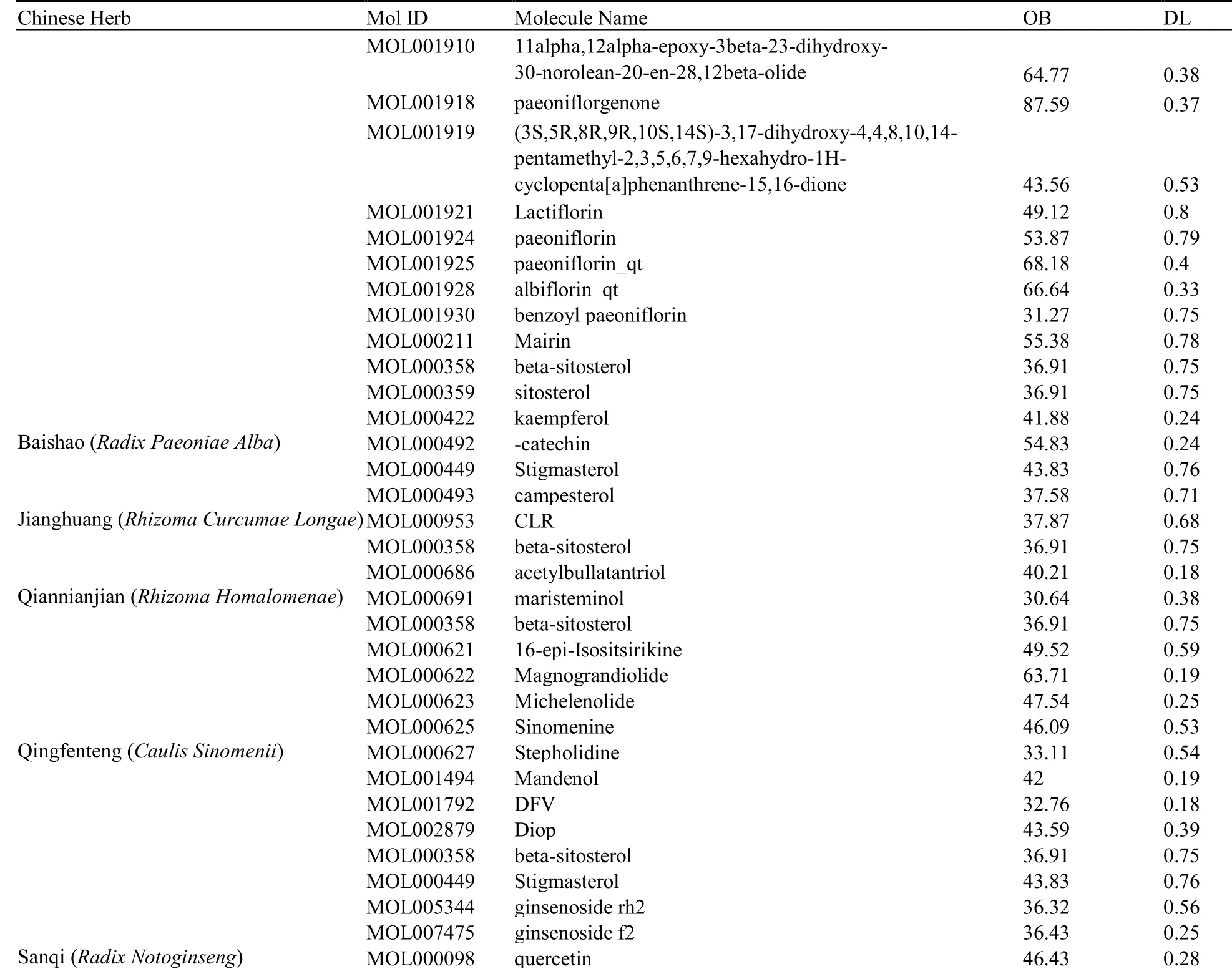
Table 1 Basic information of 33 active compounds from TCMSP
3.2.Venn diagram of the JWJG targets and OA targets
Z-score <-1.0 was regarded as a standard score,the related target proteins were screened out based on molecular-target protein docking results,and converted into the corresponding gene names using the UniProt database.If a PBD ID corresponded to multiple genes,the target protein content was confirmed to ensure that one protein corresponded to one gene.Consequently,602 target genes were obtained,and 2497 OA related genes were exported from the GeneCards and OMIM databases.Through JWJG active compounds-OA target related gene mapping,203 overlapped genes were identified as the target genes of JWJG in treating OA,illustrated in Figure 1A.
3.3.JWJG targets-OA interaction network
The JWJG compound targets-CRC target group network of the candidate chemical compounds and OA targets was established via Cytoscape 3.7.2.This diagram of JWJG targets-OA interaction was mainly composed of 172 nodes,32 target nodes,140 disease nodes,and 534 edges.Red indicated OA,yellow indicated JWJG,the blue nodes indicated the JWJG active compounds,and the green nodes indicated the OA targets.Each edge represented the interaction between active compounds of JWJG and OA targets (Figure 1B).In the JWJG targets-OA targets network diagram,32 main compounds in JWJG acted on the disease targets,featuring multicompounds and multi-targets.The active compounds beta-sitosterol,emodin,quercetin,3-hydroxyl-gammapyrone,kaempferol,hexadecanoic acid,and stepholidine containing in the herbs represented the material basis of JWJG in OA treatment.
3.4.Target PPI network diagram and key gene analysis
The PPI network diagram contained 201 target protein nodes and 906 interaction edges.As illustrated in Figure 2A,high degree proteins were interleukin-6 (IL-6)(degree=137),insulin (INS) (degree=130),protein kinase B (AKT1) (degree=129),glyceraldehyde-3-phosphate dehydrogenase (degree=129),vascular endothelial growth factor A (degree=118) and interleukin 1 beta (degree=106) exerting critical roles in the interactions (Figure 2B).
3.5.GO biological process analysis
The 203 target genes were enriched through GO biological processes using the DAVID database,and 158 entries were screened with a false discovery rate (FDR)<0.05.The top entries were cofactor binding,cytokine receptor binding,endopeptidase activity,DNA-binding transcription activator activity,RNA polymerase IIspecific,receptor regulator activity,proximal promoter sequence-specific DNA binding,protein heterodimerization activity,receptor ligand activity,and RNA polymerase Ⅱ proximal promoter sequence-specific DNA binding,as illustrated in Figure 2C-2D.Taken together,the occurrence and development of OA linked to biological processes including protein activity,transcription factor activity,and the transcriptional regulation of DNA and RNA,and JWJG can treat OA by regulating biological processes described previously.
3.6.KEGG signaling pathway analysis
The 203 overlapped genes were imported into the DAVID database for KEGG signaling pathway enrichment,and those intimately related to OA were screened out under the condition of FDR <0.05.A total of 188 target genes were involved in the KEGG enrichment pathways,including Kaposi sarcomaassociated herpesvirus infection,Hepatitis B,Human cytomegalovirus infection,advanced glycation end products-receptor for advanced glycation end products signaling pathway in diabetic complications,phosphorinositide 3-kinase-protein kinase B (PI3K-Akt)signaling pathway,and Wnt signaling pathway.They were mainly associated with cell cycles,inflammation,infection,and cancer.Each pathway had one corresponding pathway map as presented in Figure 2E.It was speculated that JWJG may play a role in OA treatment mainly by regulating the key genes mentioned previously and affecting related signaling pathways.The relationship between target genes and pathways was presented in Table 3.
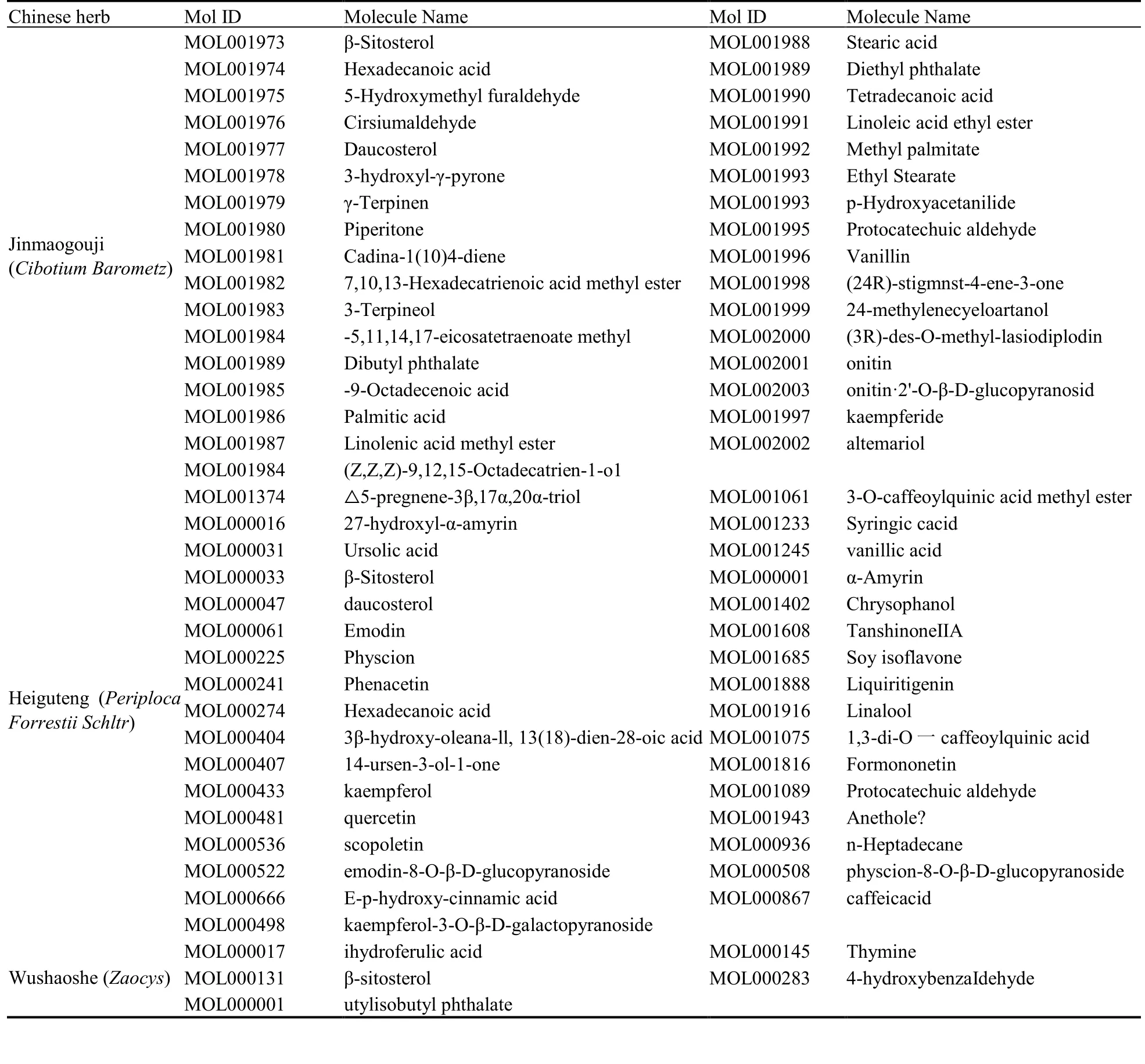
Table 2 Basic information of 77 active compounds from ChemMapper
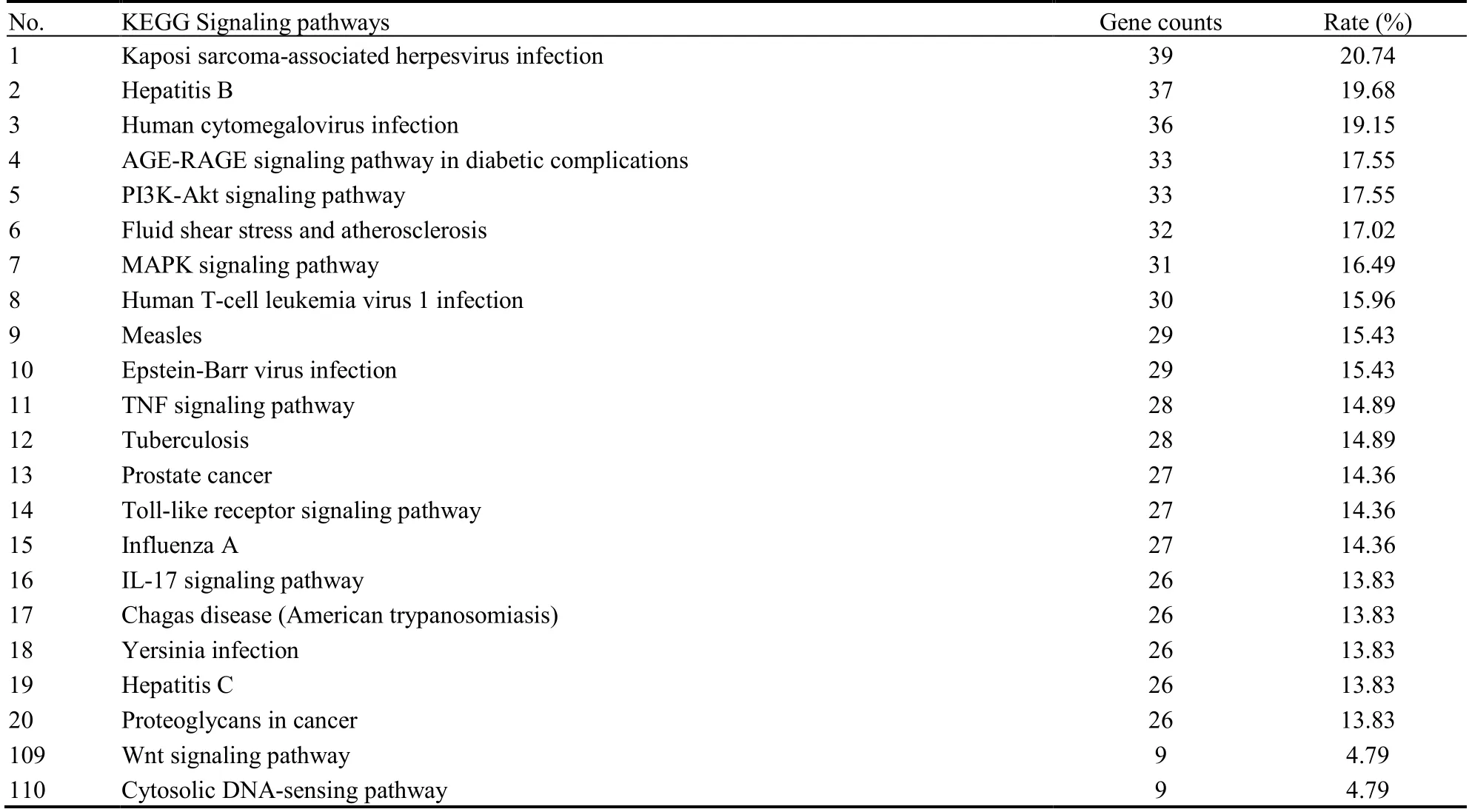
Table 3 JWJG KEGG enrichment pathways
3.7.HE staining results indicate an effective rle of JWJG in protecting chondrocytes
Based on previous literature research and analysis of network pharmacology,we hypothesized that JWJG might role in OA treatment through the Wnt signaling transduction pathway and verified using animal experiments.
Some chondrocytes in the blank group were evenly distributed and neatly arranged under a microscope.Conversely,decreased chondrocytes were randomly arranged with blood vessels passing through in the model group.Irregular calcium salt deposition and ossification were visualized in some cases.Cell arrangement in the meloxicam control group and glucosamine control group was slightly disordered,but hierarchically layered,with blood vessels passing through occasionally.In the high,medium,and low dose JWJG groups,the higher dose was administered,the closer cell count and distribution were to the blank group (Figure 3A).
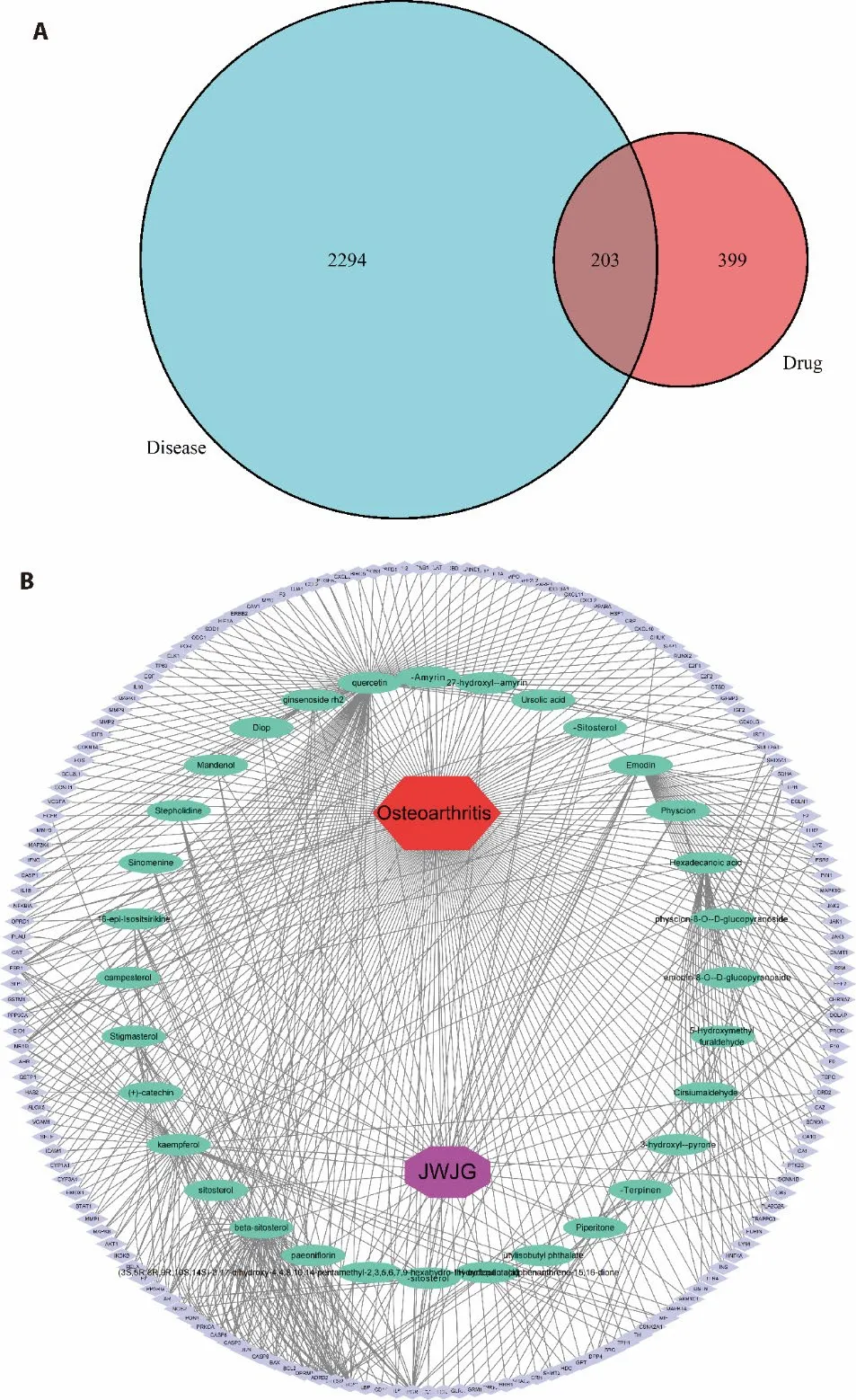
Figure 1 Network pharmacology analysis of JWJG-compound-target-OA relationship
The pathological Mankin's scores of rabbit knee cartilage of each group was 1.40 ± 0.49 (blank group),9.30 ± 0.90(model group),7.60 ± 0.92 (low dose JWJG group),4.70± 0.64 (medium dose JWJG group),3.50 ± 0.81 (high dose JWJG group),4.80±0.87 (meloxicam control group)and 4.50 ± 0.92 (glucosamine control group).The pathological Mankin’s score in the model group were markedly higher than those in the blank group (P <0.05)whereas those of the treatment groups were markedly lower than the model group (P <0.05),but higher than the blank group,and the difference was statistically significant (P <0.05).Compared within the treatment groups,no statistically significant difference was revealed between the medium dose JWJG group,the meloxicam control group and glucosamine control group,meloxicam control group,and the glucosamine control group (P=0.78,0.59,and 0.48).Statistical significance was revealed in the remaining groups (P <0.05).Mankin's scores from the lowest to the highest were the high and,medium dose JWJG groups,glucosamine control group,meloxicam control group,and the low dose JWJG group.
3.8.Regulatory effects of JWJG on the predicted targets by WB and qPCR
The expressions of Axin,GSK-3β,and β-catenin were detected by WB.The results indicated that JWJG could increase the protein expression of Axin and decrease those of GSK-3β and β-catenin in a dose-dependent manner (Figure 3B).The mRNA expressions of Axin,GSK-3β,β-catenin,Wnt2a,Wnt5a,BMP2,MMP13,cylinD1,MYC,and APC were detected by qPCR.The results suggested that JWJG could reduce the expressions of GSK-3β,β-catenin,Wnt2a,Wnt5a,BMP2,MMP13,cylinD1,and MYC and increase those of Axin and APC(Figure 3C).
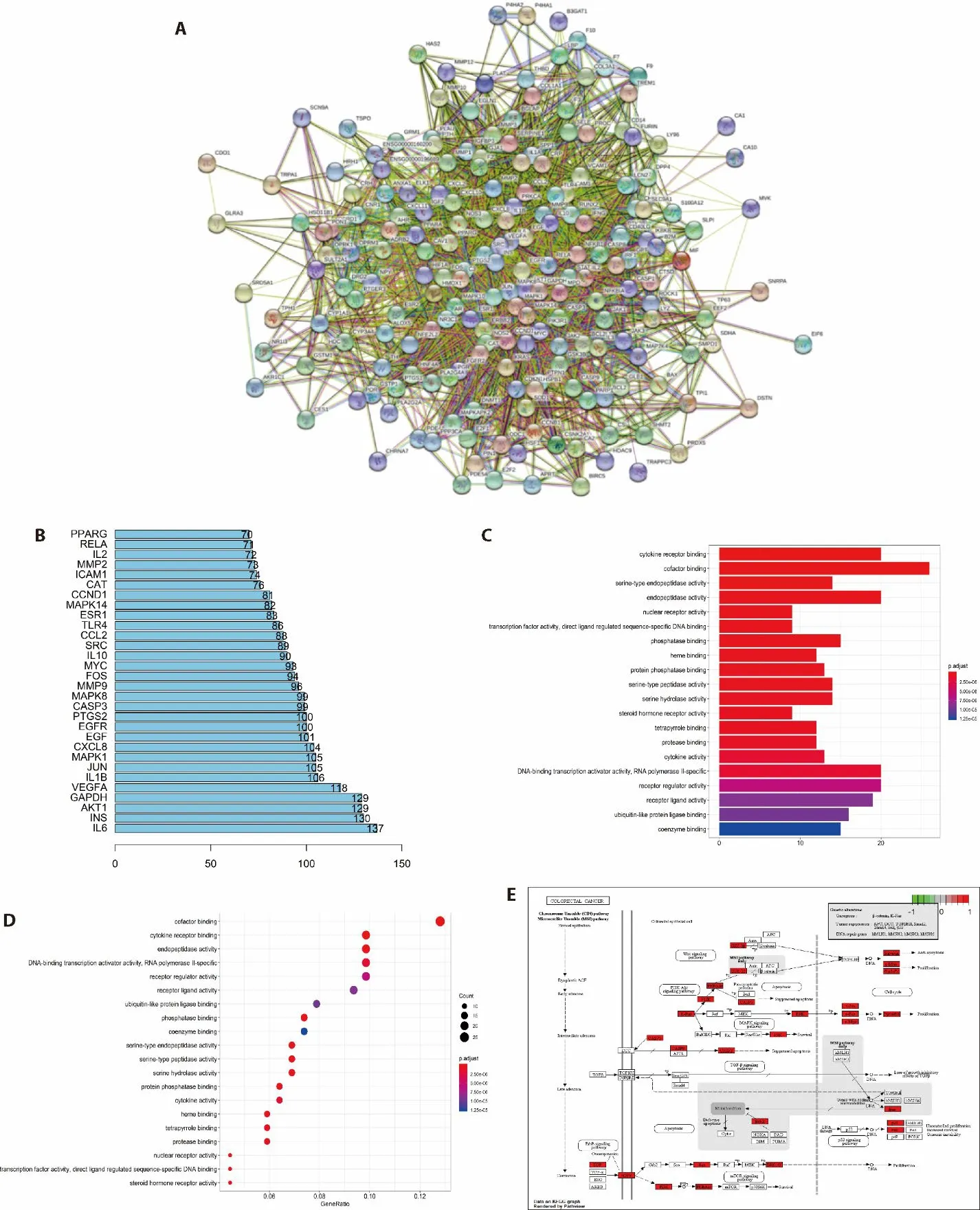
Figure 2 PPI,GO and KEGG analysis of the targets

Figure 3 Regulatory effects of JWJG in protecting chondrocytes
4.DISCUSSION
TCM has a long history of treating OA with satisfactory efficacy and few adverse reactions.14Previous studies have demonstrated that TCM combined with Western medicine can exert synergistic effects in minimizing drug side effects,delaying joint deterioration,and reducing the risk of joint replacement.15,16Miao medicine,as a TCM inherited thousands of years ago,has been introduced in OA treatment,but the treatment mechanism remains unclear.17The present study aimed to systematically analyze the mechanism of JWJG in OA treatment in a network pharmacology approach.Ninetytwo major chemical constituents of JWJG were retrieved using the TCMSP database,among which,paeoniflorgenone and paeoniflorin were anti-inflammatory active constituents.The enriched pathways described previously indicated that JWJG was effective in OA treatment mainly affecting pathways related to cell cycle,inflammation,infection,and cancer.The essential pathways in OA treatment included the TNF,IL-17,PI3K-Akt,mitogen-activated protein kinases,NF-kappa B,JAK-STAT,and Wnt signaling pathways.
The Wnt signaling pathway is mediated by β-catenin,which involves multiple proteins and is highly conserved.The principal compounds encompass secretion of Wnt proteins,transmembrane receptors of the Frz family,CK1,Deshevelled,Glycogen synthase kinase-3 (GSK3),adenomatous polyposis coli (APC),Axin,β-Catenin,and transcription factors of the TCF/LEF family.18Furthermore,the concentration of β-catenin directly determines the activation of the Wnt signaling pathway.At low concentrations,β-catenin binds to Axin,GSK3,and APC and forms a complex,allowing the phosphorylation of β-catenin and stabilization of the intranuclear structure.As a result,β-catenin cannot enter the nucleus,which inhibits the expression of Wnt-related target genes in the nucleus,thereby inactivating the Wnt signaling transduction.Conversely,at an extremely high concentration,β-catenin can express Wnt-related target genes and participate in multiple physiological and pathological changes.11Axin,as a protein scaffold of the Wnt/β-catenin signaling pathway,maintains the spatial structure of the Wnt signaling pathway whether or not the pathway is activated.It binds to GSK-3β,APC,CKlα,β-catenin to form a complex which inactivates GSK-3β,directly participates in the entire processes of β-catenin phosphorylation,degradation,and stability maintenance,and plays a major role in negative regulation.19OA occurs as a result of the destruction of bone balance,loss of articular cartilage,and even cartilage sclerosis.Maturation and apoptosis of chondrocytes are the major factors of OA,20and the Wnt signaling pathway regulates the synthesis and decomposition of extracellular matrix in articular chondrocytes.21The complex of the Wnt pathway affects the division,differentiation,and maturation of osteoblasts,causing insufficient bone formation.22A study has reported that overexpressed βcatenin can increase the expressions of MMP-2,MMP-3,MMP-7,MMP-9,MMP-13,and ADAMTS5.23Highly expressed MMP13 can be observed in patients with articular cartilage destruction,which can be employed as a marker of articular cartilage injury in OA.24The expression of β-catenin can stimulate MMPs,increase the expression of a bone morphogenetic protein (BMP),cause cartilage matrix degradation,accelerate chondrocytes apoptosis,thereby leading to the destruction of articular cartilage.25All the described studies have indicated that the occurrence and development of OA are intimately related to Wnt/βcatenin.
Following 4 weeks of modeling,different drugs were administered intragastrically for 4 weeks,and the rabbit knee cartilage was obtained for pathological detection.The results revealed that evenly distributed chondrocytes were visualized in the blank group,whereas fewer irregularly distributed and dispersed chondrocytes were observed in the model group.The quantity and distribution of chondrocytes in the meloxicam group and glucosamine hydrochloride group were similar to those in the normal group.In the low,medium,and high dose TCM groups,the higher the dose,the closer the quantity and distribution to the blank group.
The expression levels of Axin,GSK-3β,and β-catenin were detected and the results indicated that the expression of GSK-3β and β-catenin protein was the highest whereas that of Axin protein was the lowest in the model group.The difference was significant compared with the blank group (P <0.05).The expression levels of GSK-3β and β-catenin protein were decreased (P <0.05) whereas the expression level of Axin protein was increased in each treatment group compared with the model group (P <0.05).No significant difference was revealed in the expression of GSK-3β protein in the low dose JWJG and glucosamine hydrochloride control groups (P=0.058),compared within the treatment groups,but statistical significance was revealed in the remaining groups (P <0.05).The protein expression levels of GSK-3β and β-catenin protein from high to low were the glucosamine control group,the low dose JWJG group,the meloxicam control group,the medium dose JWJG group,and the high dose JWJG group.The Axin protein expressions from low to high were the low dose JWJG group,the glucosamine control group,the meloxicam control group,the medium and high dose JWJG groups.
The results of reverse transcription-polymerase chain reaction revealed that the mRNA expressions of GSK-3β,β-catenin,Wnt2a,Wnt5a,cylinD1,MYC,MMP13,and BMP2 in the model group increased (P <0.05),whereas that of the Axin and APC mRNA expressions decreased compared with the blank group (P <0.05).The mRNA expressions of GSK-3β,β-catenin,Wnt2a,Wnt5a,cylinD1,MYC,MMP13,and BMP2 in various doses of the JWJG groups were lower than those in the model group (P <0.05),and the expression of the high dose group was dramatically downregulated (P <0.05).Axin and APC mRNA expressions presented an opposite result.Compared within the treatment groups,the mRNA expressions of MYC,Wnt2a,and Wnt5a in the high dose JWJG group were similar to those in the meloxicam and the glucosamine hydrochloride control groups and no significant difference (P=0.088,0.157,0.054,0.053,0.098,and 0.294) was revealed.The detected indicators in the glucosamine control group and the meloxicam control group revealed no statistical significance (P>0.05),whereas statistical significance was revealed in the remaining groups (P<0.05).Additionally,the groups with the mRNA expression levels of Wnt2a,MYC,and BMP2 from high to low were the low dose JWJG group,the medium dose JWJG group,the meloxicam control group,the glucosamine control group,and the high dose JWJG group.mRNA expression levels of Wnt5a,cylinD1,and MMP13 from high to low was the low dose JWJG group,the medium dose JWJG group,the glucosamine control group,the meloxicam control group,and the high dose JWJG group.And the APC mRNA expression from low to high was the high dose JWJG group,the glucosamine hydrochloride control group,the meloxicam control group,the medium dose JWJG group,and the low dose JWJG group.
Taken together,we explored the molecular-target mechanism of JWJG in OA treatment in a network pharmacology approach.The present study is expected to serve as a molecular theoretical basis for OA treatment,and to provide a novel orientation for subsequent research and therapeutic option development.
In conclusion,this study preliminarily analyzed the pharmacological mechanism of JWJG in treating OA in a network pharmacological approach,providing great theoretical significance for clinical application.
5.REFERENCES
1.Malemud CJ.Biologic basis of osteoarthritis:state of the evidence.Curr Opin Rheumatol 2015;27:289-94.
2.Prieto-Alhambra D,Judge A,Javaid MK,et al.Incidence and risk factors for clinically diagnosed knee,hip and hand osteoarthritis:influences of age,gender and osteoarthritis affecting other joints.Ann Rheum Dis 2014;73:1659-64.
3.Dabholkar T,Dabholkar A,Sachiwala D.Correlation of the core stability measures with the hip strength and functional activity level in knee osteoarthritis.Int J Rehabil Res 2016;5:37-43.
4.Mi?dzyb?ocka M,Czarnecki P.Evaluation of the effectiveness of hyaluronic acid injections in treatment of small joint osteoarthritis.Ortop Traumatol Rehabil 2018;20:437-43.
5.de l'Escalopier N,Anract P,Biau D.Surgical treatments for osteoarthritis.Ann Phys Rehabil Med 2016;59:227-33.
6.Arias-Vázquez PI,Tovilla-Zárate CA,Hernández-Díaz Y,et al.Short-term therapeutic effects of ozone in the management of pain in knee osteoarthritis:a Meta-analysis.PM R 2019;11:879-87.
7.Huh SW,Shetty AA,Kim JM,et al.Autologous bone marrow mesenchymal cell induced chondrogenesis for the treatment of osteoarthritis of knee.Tissue Eng Regen Med 2016;13:200-9.
8.Chen L,Lu X,Lan W,et al.Clinical study on the treatment of knee osteoarthritis with Kidney deficiency and blood stasis by Jinwu Jiangu prescription.Guiyang Zhong Yi Xue Yuan Xue Bao 2018;40:54-7.
9.Feng Z,Xiao Q,Lian K.Research progress of Wnt signaling pathway and osteoarthritis.Jilin Yi Xue 2017;38:383-6.
10.Xie W,Zheng H.Research progress of Traditional Chinese Medicine in the intervention of osteoarthritis based on Wnt/βcatenin signaling pathway.Zhong Guo Gu Zhi Shu Song Za Zhi 2018;24:664-70.
11.Zhou Y,Wang T,Hamilton JL,et al.Wnt/β-catenin signaling in osteoarthritis and in other forms of arthritis.Curr Rheumatol Rep 2017;19:53.
12.Huang J,Huang X,Chen Z,et al.Dose conversion among different animals and healthy volunteers in pharmacological study.Zhong Guo Lin Chuang Yao Li Xue Yu Zhi Liao Xue 2004;9:1069-72.
13.Mankin HJ,Dorfman H,Lippiello L,et al.Biochemical and metabolic abnormalities in articular cartilage from osteo-arthritic human hips.II.Correlation of morphology with biochemical and metabolic data.J Bone Joint Surg Am 1971;53:523-37.
14.Yang M,Jiang L,Wang Q,et al.Traditional Chinese Medicine for knee osteoarthritis:an overview of systematic review.PLoS One 2017;12:e0189884.
15.Xu YK,Zhu FG,Feng EY,et al.External therapies of traditional Chinese medicine combined with sodium hyaluronate injected in articular cavity therapy on knee osteoarthritis:Meta-analysis.Zhong Guo Zhong Yao Za Zhi 2018;43:1934-9.
16.Lo PC,Lin FC,Tsai YC,et al.Traditional Chinese Medicine therapy reduces the risk of total knee replacement in patients with knee osteoarthritis.Medicine (Baltimore) 2019;98:e15964.
17.Gu P,Zhu L,Liu Y,et al.Protective effects of paeoniflorin on TNBS-induced ulcerative colitis through inhibiting NF-kappa B pathway and apoptosis in mice.Int Immunopharmacol 2017;50:152-60.
18.Arai E,Sakamoto H,Ichikawa H,et al.Multilayer-omics analysis of renal cell carcinoma,including the whole exome,methylome and transcriptome.Int J Cancer 2014;135:1330-42.
19.Song X,Cai W,Li L.Axin PPI networks:new interacting proteins and new targets? Curr Top Med Chem 2016;16:3678-90.
20.Hwang HS,Kim HA.Chondrocyte apoptosis in the pathogenesis of osteoarthritis.Int J Mol Sci 2015;16:26035-54.
21.Ma B,Landman EBM,Miclea RL,et al.WNT signaling and cartilage:of mice and men.Calcif Tissue Int 2013;92:399-411.
22.Schmitz Y,Rateitschak K,Wolkenhauer O.Analysing the impact of nucleo-cytoplasmic shuttling of β-catenin and its antagonists APC,Axin and GSK3 on Wnt/β-catenin signalling.Cell Signal 2013;25:2210-21.
23.Zhang L,Ma S,Su H,et al.Isoliquiritigenin inhibits IL-1betainduced production of matrix metalloproteinase in articular chondrocytes.Mol Ther Methods Clin Dev 2018;9:153-9.
24.Gillis WQ,Kirmizitas A,Iwasaki Y,et al.Gtpbp2 is a positive regulator of Wnt signaling and maintains low levels of the Wnt negative regulator Axin.Cell Commun Signal 2016;14:15.
25.Li J,Zhou XD,Yang KH,et al.Hinokitiol reduces matrix metalloproteinase expression by inhibiting Wnt/β-Catenin signalingin vitroandin vivo.Int Immunopharmacol 2014;23:85-91.
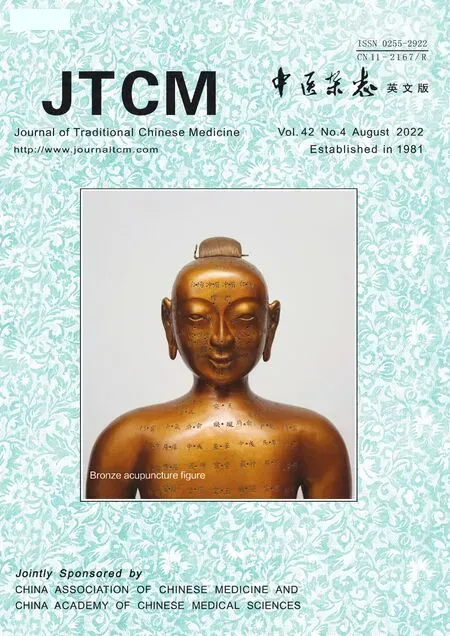 Journal of Traditional Chinese Medicine2022年4期
Journal of Traditional Chinese Medicine2022年4期
- Journal of Traditional Chinese Medicine的其它文章
- Editorial Board Listing
- Mixed methods research in complementary and alternative medicine:a scoping review
- Herbal anthelmintic agents:a narrative review
- Factors influencing physician's behavioral intention to use Traditional Chinese Medicine to treat coronavirus disease 2019 based on the theory of planned behavior
- Identification of novel biomarkers and therapeutic target candidates for stasis-heat symptom pattern of acute intracerebral hemorrhage by quantitative plasma proteomics
- Effect of three tongue needles acupoints Lianquan (CV23) and Hegu(LI4) combined with swallowing training on the quality of life of laryngeal cancer patients with dysphagia after surgery
